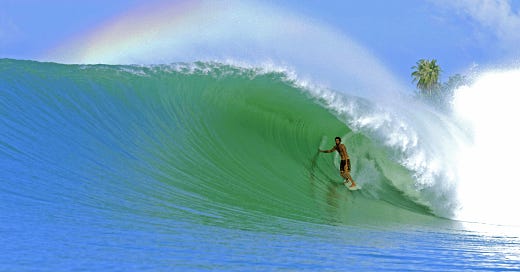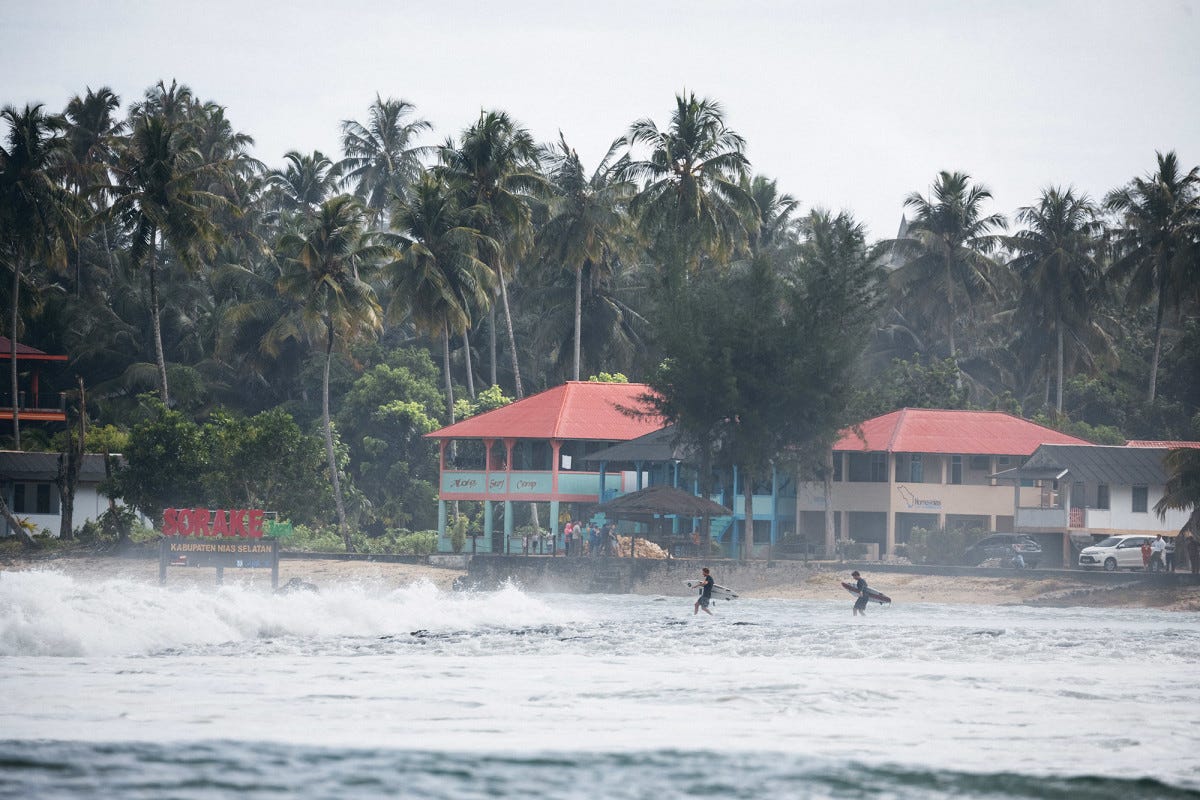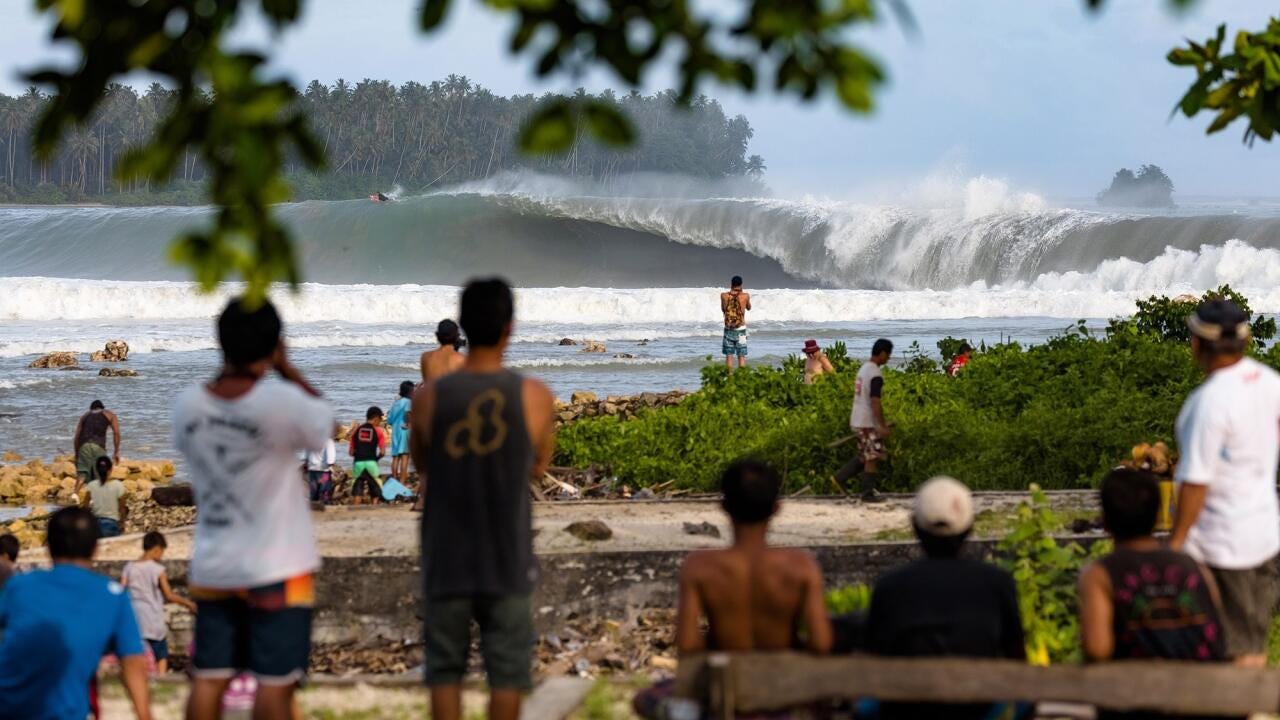Located at the village Sorakhe on the western side of Lagundri Bay, the break was first discovered in 1975 by Australian surfers Kevin Lovett, John Geisel and Peter Troy. The trio kept its location relatively quiet, determined to enjoy a true surfing paradise on their own. However, surfers tend to define secrets in two ways; either they are too good to keep or not worth keeping.
That meant the word soon got out. When the dreamy images of the jungle-backed wave first appeared in surf magazines and movies in the early 1980s, the break known simply as Nias quickly became bucket list and a byword for perfection and adventure. The sun-drenched horseshoe bay ringed by a dense mass of coconut palms came with a rare Indonesian right-hander of incredible quality.
Nine times out of 10 a surfer would stroke in effortlessly, negotiate the relatively easy drop, and pull up into a perfect, almond-shaped, cylinder. 300 yards down the line, having negotiated the whole wave inside the tube at Mach speed, the surfer would be spat out into the safety of the deep channel. Not for nothing was this wave known as the best seven seconds in surfing.
Its isolated location on the southern side of the Island Nias, itself 60 miles off the North Sumatran mainland, was a key factor in its mythology. It was then, and remains today, an arduous mission to travel there. The early pathway was a flight from Singapore or Bali to the Sumatran city of Medan. Then came a 10-hour bus trip to the port of Sibolga. After an overnight stay, a six-hour ferry trip would get you to the Nias capital of Gunungsitoli. Then it was just another six-hour bemo, or minivan, ride to Sorakhe. More recently flights from Medan to Gunungsitoli have shortened the journey, but it remains both a test of patience and resolve.
After all that effort surfers who came tended to stay for the long haul. Many devotees would return each year and reside with the same local families for months on end. It was a simple life based on a diet of home-cooked Indonesian food, fresh fruit and incredible waves. Life remained the same for 40 years, until suddenly the whole landscape, literally, changed.
On March 28, 2005, the island of Nias was 50 miles from the epicentre of an earthquake that measured 8.6 on the Richter scale. It forced the Indo-Australian tectonic plate under the Eurasian Plate's Sunda edge and the whole island was levered up as if by a giant crowbar. In some places on the coast coral banks as high as two metres stood where there was once deep water.
The effects were tragic with countless homes destroyed and almost 1000 people left dead on the island of Nias alone. The quake had a huge effect on the waves in the area. The nearby Hinako Island breaks of Bawa and Asu were disfigured almost beyond repair. It was a trivial loss compared to that suffered by the local communities, but hundreds of waves in the area were either lost or changed for the worse.
And yet Lagrundi, miraculously, was still alive and arguably improved. The pre-earthquake version that had needed at least a six-foot swell to break, now produced quality waves at half that size. That meant not only were there more days of rideable waves, it was also more approachable for beginners and intermediate surfers.
At the other end of the spectrum, when the pounding, long-period swells did pour into Lagundri Bay, the wave became a throaty beast that had few rivals in terms of hollowness in all of Indonesia. Jamie O’Brien probably first alerted the surfing world to its new potential when the footage of him surfing giant slabs at Lagrundi was featured in his 2011 movie Who Is JOB.
Since then it has become a mecca for some of the world’s best big wave slab hunters. In 2018 professional surfers scrambled from all over the world to surf a giant swell here. Hawaiian Mark Healey was credited with riding the biggest wave in the wave’s history during that swell.
“It remains one of my favourite waves in the world, and the place where I’ve had some of my most special moments,” South African charger Matt Bromley told The Surf Bugle. “The wave, the people and the scenery have a magnetic pull. It always brings me back.”
That magnetic pull had the same effect on pioneers in the 1970s as it does today. Nias' history is unique, but its future as one of the world’s most epic waves set in one of the most iconic locations remains ever true.
All You Need To Know
Type of wave: Righthand, tubing reef break that features a dry-haired paddle out next to the break.
Best conditions: Most consistent in the dry season from May to September. Off-season is less consistent in terms of swell, but also less crowded.
Nearest town: Teluk Dalam is the nearest town for gathering supplies, but staying in front of the wave in the village of Sorakhe is the only real option.
Getting there: Nearest airport is Binaka Airport (GNS) in the Nias capital of Gunungsitoli. There are daily flights from there to Medan, which has international air links with Jakarta Denpasar, Singapore and Kuala Lumpur.
Where to stay: There are a range of losmens or guesthouses, plus newer resorts and surf camps that line the point. Kabu Nohi is run by Australian expat and 30-year Nias resident Mark Flint, is one of the best and closest to the wave and costs around $US100 pp per night.
Things to know: Malaria and dengue fever are still a threat on Nias and malaria vaccinations are recommended.
Fun Fact
In 1989 Coca-Cola made a “You Can’t Beat The Feeling” commercial featuring professional surfers Luke Egan, Jodie Cooper, Stuart Bedford-Brown and Kye Fitzgerald travelling to surf an “undiscovered” perfect wave, aka Lagrundi Bay. When the technicolor waves of Nias were beamed into the living rooms of mainstream Australia and New Zealand interest in the wave hit an all-time high. The ad was deemed responsible for Nias having its most crowded surf seasons in history throughout the early 1990s.






